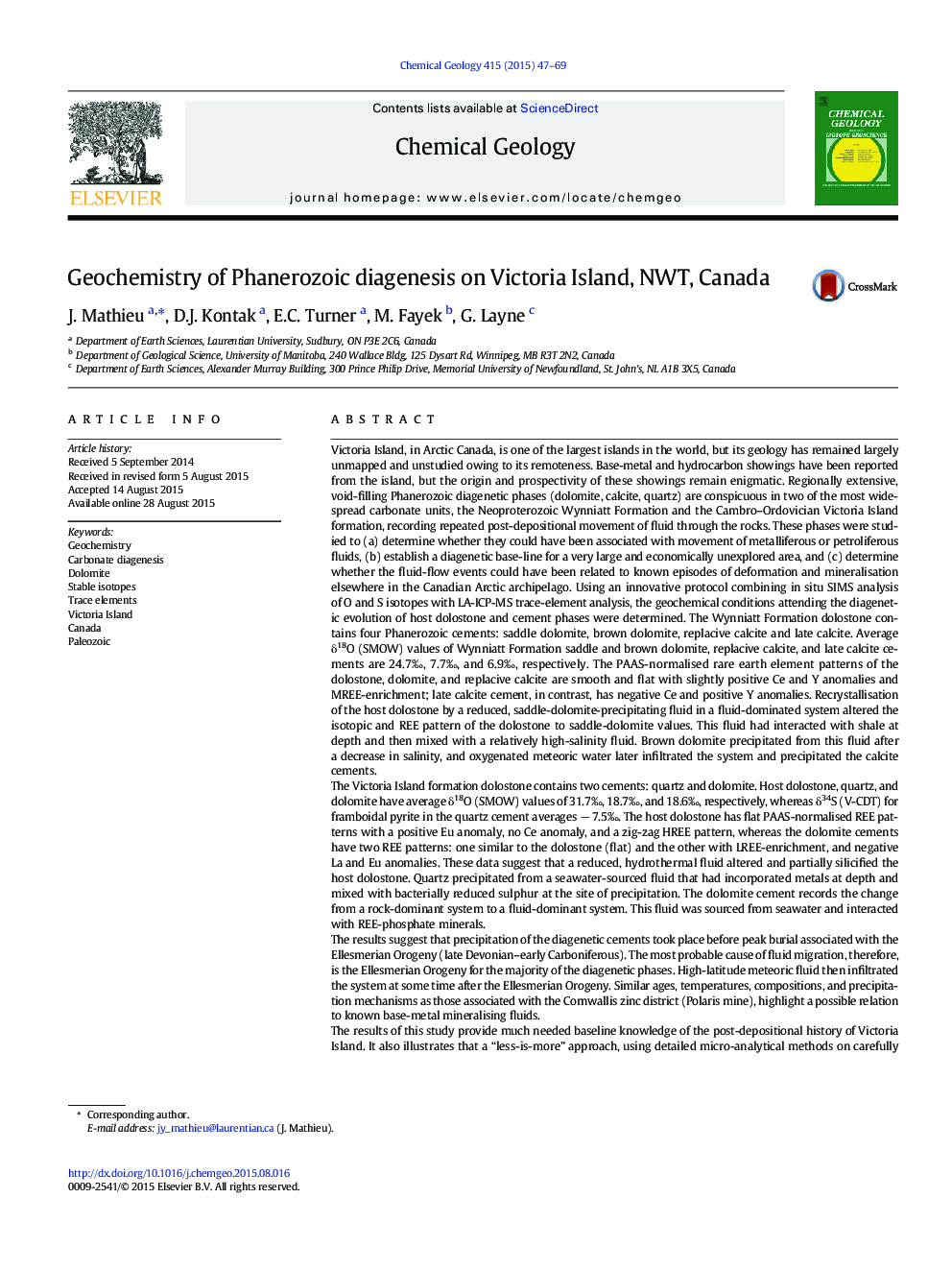| کد مقاله | کد نشریه | سال انتشار | مقاله انگلیسی | نسخه تمام متن |
|---|---|---|---|---|
| 6436223 | 1637559 | 2015 | 23 صفحه PDF | دانلود رایگان |

- A novel approach to the study of diagenesis
- Multiple in-situ microanalytical methods were used to constrain fluid characteristics.
- Water-rock ratios changed from low to high during diagenesis at both sites.
- This approach provides a level of detail that has not been attained in typical studies.
Victoria Island, in Arctic Canada, is one of the largest islands in the world, but its geology has remained largely unmapped and unstudied owing to its remoteness. Base-metal and hydrocarbon showings have been reported from the island, but the origin and prospectivity of these showings remain enigmatic. Regionally extensive, void-filling Phanerozoic diagenetic phases (dolomite, calcite, quartz) are conspicuous in two of the most widespread carbonate units, the Neoproterozoic Wynniatt Formation and the Cambro-Ordovician Victoria Island formation, recording repeated post-depositional movement of fluid through the rocks. These phases were studied to (a) determine whether they could have been associated with movement of metalliferous or petroliferous fluids, (b) establish a diagenetic base-line for a very large and economically unexplored area, and (c) determine whether the fluid-flow events could have been related to known episodes of deformation and mineralisation elsewhere in the Canadian Arctic archipelago. Using an innovative protocol combining in situ SIMS analysis of O and S isotopes with LA-ICP-MS trace-element analysis, the geochemical conditions attending the diagenetic evolution of host dolostone and cement phases were determined. The Wynniatt Formation dolostone contains four Phanerozoic cements: saddle dolomite, brown dolomite, replacive calcite and late calcite. Average δ18O (SMOW) values of Wynniatt Formation saddle and brown dolomite, replacive calcite, and late calcite cements are 24.7â°, 7.7â°, and 6.9â°, respectively. The PAAS-normalised rare earth element patterns of the dolostone, dolomite, and replacive calcite are smooth and flat with slightly positive Ce and Y anomalies and MREE-enrichment; late calcite cement, in contrast, has negative Ce and positive Y anomalies. Recrystallisation of the host dolostone by a reduced, saddle-dolomite-precipitating fluid in a fluid-dominated system altered the isotopic and REE pattern of the dolostone to saddle-dolomite values. This fluid had interacted with shale at depth and then mixed with a relatively high-salinity fluid. Brown dolomite precipitated from this fluid after a decrease in salinity, and oxygenated meteoric water later infiltrated the system and precipitated the calcite cements.The Victoria Island formation dolostone contains two cements: quartz and dolomite. Host dolostone, quartz, and dolomite have average δ18O (SMOW) values of 31.7â°, 18.7â°, and 18.6â°, respectively, whereas δ34S (V-CDT) for framboidal pyrite in the quartz cement averages â 7.5â°. The host dolostone has flat PAAS-normalised REE patterns with a positive Eu anomaly, no Ce anomaly, and a zig-zag HREE pattern, whereas the dolomite cements have two REE patterns: one similar to the dolostone (flat) and the other with LREE-enrichment, and negative La and Eu anomalies. These data suggest that a reduced, hydrothermal fluid altered and partially silicified the host dolostone. Quartz precipitated from a seawater-sourced fluid that had incorporated metals at depth and mixed with bacterially reduced sulphur at the site of precipitation. The dolomite cement records the change from a rock-dominant system to a fluid-dominant system. This fluid was sourced from seawater and interacted with REE-phosphate minerals.The results suggest that precipitation of the diagenetic cements took place before peak burial associated with the Ellesmerian Orogeny (late Devonian-early Carboniferous). The most probable cause of fluid migration, therefore, is the Ellesmerian Orogeny for the majority of the diagenetic phases. High-latitude meteoric fluid then infiltrated the system at some time after the Ellesmerian Orogeny. Similar ages, temperatures, compositions, and precipitation mechanisms as those associated with the Cornwallis zinc district (Polaris mine), highlight a possible relation to known base-metal mineralising fluids.The results of this study provide much needed baseline knowledge of the post-depositional history of Victoria Island. It also illustrates that a “less-is-more” approach, using detailed micro-analytical methods on carefully selected and well-constrained samples, allows one to decipher a complex diagenetic history involving the mixing of fluids from different reservoirs and frequent changes in redox state, both of which may be overlooked using conventional macro-scale approaches.
Journal: Chemical Geology - Volume 415, 15 November 2015, Pages 47-69